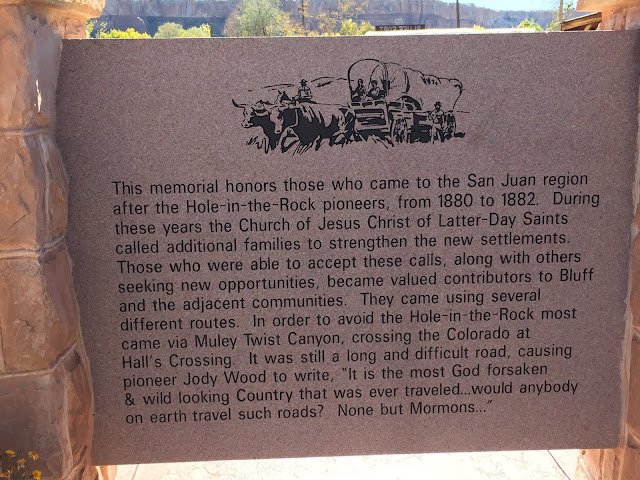On Friday, Oct. 18th we went in search of petroglyphs in the southern Utah area around Bluff, UT. Petroglyphs are rock carvings made by pecking directly on the stone surface using a stone chisel and hammer, depicting animals, people, successful hunting ventures, long trips, and even war events. When the rock varnish (thin dark or discolored patina on the rock surface) is chipped away the lighter colored rock beneath the surface is exposed revealing the petroglyph image.
The first area we went searching for was the "Wolfman Panel" in Butler Wash, near Bluff, Utah. We drove up a very bad unimproved road for a short distance, not having very accurate directions, and finally asked some lady campers where the petroglyphs were. They weren't sure but thought the panel might be down in a canyon nearby.
We hiked down a steep slope into a narrow canyon, partly on the washed-out road you see below, but we could not find the petroglyph panel. There is a drop-off of over one hundred feet to the left of this photograph and no guardrails. We left disappointed, and moved on.
After exploring the panels and eating our lunch we drove back to Bluff to see the restored fort that is situated on the very grounds the original Mormon settlement occupied in the 1800s.
Next we drove a few miles further to Sand Island Recreation Area a few miles past Bluff, Utah, on Route 191. Here we found several petroglyph panels with hundreds of petroglyphs dating from 300 hundred years to 3,500 years old.
After exploring the panels and eating our lunch we drove back to Bluff to see the restored fort that is situated on the very grounds the original Mormon settlement occupied in the 1800s.
The elders of the Mormon church wished to settle the area of southern Utah and recruited families to brave the harsh terrain and desolate landscape to establish settlements. In April 1880, some 250 pioneers concluded a six-month, seemingly impossible journey, through inhospitable yet breathtakingly beautiful terrain to build the San Juan Mission and a small fort in the place where Bluff, Utah is today.
After establishing Bluff, Utah, some of the families moved on to establish more settlements in Blanding, Monticello and Moab, Utah. All are thriving communities today.
On the way back to Blanding we stopped at a local restaurant at the base of a canyon where Mom and Dad were delighted to find fine Vegan food on the menu. We had heard from conversations with other travelers that we should try a Navajo Taco. Fortunately, this restaurant had a vegan option, so Dad tried one and said it was delicious.
On Saturday, Oct.19th we drove about 35 miles west of Blanding, UT to Bear's Ears National Monument. There we located Mule Canyon, parked the car by the side of the dirt road, and began a long hike through the canyon in search of a unique cliff dwelling we were informed of at the visitor's center in Blanding.
Well, we found the place and had to wait for the sun to come around the corner of the canyon to see for ourselves the phenomenon that we were told about. This is what the cliff dwelling looks like before the sun strikes it.
The stone outcropping above the cliff dwelling is such that, at a particular time of day, the sun catches the hues in the rock causing it to appear to be on fire. See for yourself!
Tomorrow we are going to explore the "Trail of the Ancients" in Blanding, and Dad and Mom are going to Natural Bridges National Monument (I'm not allowed in the park this time)😐.
After establishing Bluff, Utah, some of the families moved on to establish more settlements in Blanding, Monticello and Moab, Utah. All are thriving communities today.
On the way back to Blanding we stopped at a local restaurant at the base of a canyon where Mom and Dad were delighted to find fine Vegan food on the menu. We had heard from conversations with other travelers that we should try a Navajo Taco. Fortunately, this restaurant had a vegan option, so Dad tried one and said it was delicious.
"Twin Rocks" was the name of the restaurant for a good reason.
They have a balanced rock too. Right next to the patio we ate on at the front of the building.
On Saturday, Oct.19th we drove about 35 miles west of Blanding, UT to Bear's Ears National Monument. There we located Mule Canyon, parked the car by the side of the dirt road, and began a long hike through the canyon in search of a unique cliff dwelling we were informed of at the visitor's center in Blanding.
Well, we found the place and had to wait for the sun to come around the corner of the canyon to see for ourselves the phenomenon that we were told about. This is what the cliff dwelling looks like before the sun strikes it.
The stone outcropping above the cliff dwelling is such that, at a particular time of day, the sun catches the hues in the rock causing it to appear to be on fire. See for yourself!


















That is so impressive to see!!
ReplyDelete